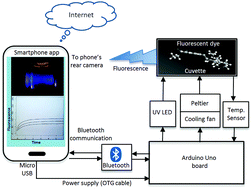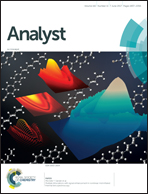Time-resolved and temperature tuneable measurements of fluorescent intensity using a smartphone fluorimeter†
Abstract
A smartphone fluorimeter capable of time-based fluorescence intensity measurements at various temperatures is reported. Excitation is provided by an integrated UV LED (λex = 370 nm) and detection obtained using the in-built CMOS camera. A Peltier is integrated to allow measurements of the intensity over T = 10 to 40 °C. All components are controlled using a smartphone battery powered Arduino microcontroller and a customised Android application that allows sequential fluorescence imaging and quantification every δt = 4 seconds. The temperature dependence of fluorescence intensity for four emitters (rhodamine B, rhodamine 6G, 5,10,15,20-tetraphenylporphyrin and 6-(1,4,8,11-tetraazacyclotetradecane)2-ethyl-naphthalimide) are characterised. The normalised fluorescence intensity over time of the latter chemosensor dye complex in the presence of Zn2+ is observed to accelerate with an increasing rate constant, k = 1.94 min−1 at T = 15 °C and k = 3.64 min−1 at T = 30 °C, approaching a factor of ∼2 with only a change in temperature of ΔT = 15 °C. Thermally tuning these twist and bend associated rates to optimise sensor approaches and device applications is proposed.

- This article is part of the themed collection: Analyst Recent Open Access Articles


 Please wait while we load your content...
Please wait while we load your content...